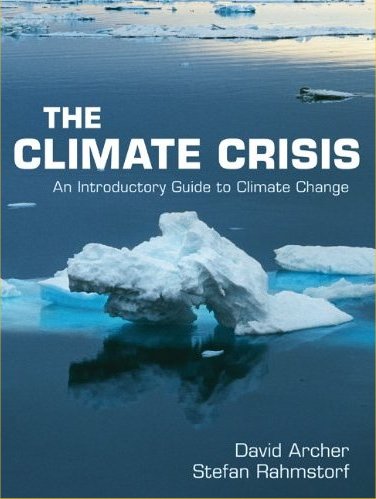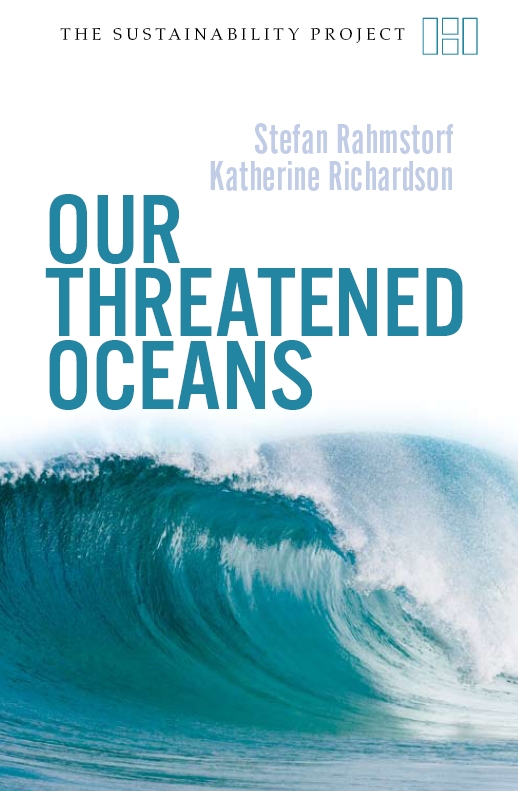Note: This article appeared in edited form under the title "Ice Cold in Paris" in New Scientist, 8 February 1997. Below is the article as originally submitted.
The Unstable Ocean
A major current system in the Atlantic, which has kept
Europe warm
during the past 10,000 years, may be quite unstable.
That Europe's lands are so green and pleasant is largely due to the warmth of the Gulf Stream; we have been told that in school. Recently, however, the Gulf Stream made negative headlines: it was blamed for abrupt, drastic changes in Europe's climate throughout the last ice age. And the latest report of the Intergovernmental Panel on Climate Change (IPCC) published in May this year raises concern that the ocean currents of the Atlantic might become unstable again, if humanity continues to meddle with the climate. A sudden shift in the currents could cool Europe by several degrees. How stable is the Gulf Stream, and is there really a risk that it might flip us into the cooler?
To look for answers to these questions, we have to head north to the cold and stormy waters off Greenland. Invisible to the few intrepid mariners who venture there, a crucial pump in the global climate machine is silently operating. This pump is deep convection. It rejuvenates the deep waters of the world ocean by driving a slow but massive overturning motion, popularly dubbed the "Ocean Conveyor Belt". Warm surface waters are drawn north throughout the Atlantic at a flow rate which exceeds a hundred Amazon rivers, sink to the deep in the Greenland and Labrador Seas, and return to the Southern Ocean as what oceanographers call "North Atlantic Deep Water" at 2-3 km depth.
Before starting their journey back south, the waters release a trillion kilowatts (10^15 W) of heat to the atmosphere, equivalent to a hundred times the world's energy consumption. The air that will blow over the Old Continent is warmed by about 5 C. This free heater has operated reliably during the past 10,000 years or so, but earlier, erratic and sudden shifts in the currents appear to have been common, rocking the climate of the region. Average temperatures could swing by 5 C or more within a few years, leading to icy spells that lasted for centuries. Climatologists have come to view the present stable times as an exception in climate history, and some are voicing concern that human interference with the climate system might trigger a new period of instability.
There are two reasons for the scientists' concern. The first is the mounting evidence for past sudden flips in the Atlantic conveyor belt. The second cause for concern is a growing understanding of the dynamical instabilities inherent in the Atlantic ocean circulation, which has recently been gained with the help of computer simulations.
The conveyor belt flow is driven by differences in salt content and temperature (which together determine the sea water density) along the Atlantic - this is why oceanographers refer to it as 'thermohaline circulation' ('haline' comes from the Greek word for salt). To push the deep water southward out of the Atlantic basin, density in the North Atlantic needs to be higher than near the latitude of Cape Hope in the South Atlantic, where the North Atlantic Deep Water joins the Antarctic Circumpolar Current which circles the planet from west to east. This deep water then partly rises back to the surface near Antarctica and partly it shoves into the other ocean basins at depth, finally reaching the North Pacific after a journey of a thousand years. The path by which it returns to the Atlantic is still hotly debated amongst oceanographers. There are two possible routes: a westward 'warm water route' via the passages of Indonesia and around South Africa, and an eastward 'cold water route' around the southern tip of South America through Drake Passage.
The thermohaline conveyor belt should not be equated with the Gulf Stream. Only the smaller part of the Gulf Stream is made up of thermohaline flow, the majority is driven by winds. An equivalent wind-driven current, the Kuroshio, also exists in the North Pacific off Japan. But it is the thermohaline flow, which is unique to the Atlantic, that really does the heating. A simple calculation shows this. Multiply the conveyor belt's flow rate of about 17 million cubic meters per second by the heat capacity of sea water (4 million Joules per cubic meter and degree celsius) and the temperature difference between the northward flowing Gulf Stream water (at 18 C) and the deep water returning southward (at 2.5 C), and you get the heating rate of about 10^15 W. The wind-driven part of the Gulf Stream, on the other hand, reaches up to a hundred million cubic meters per second in places, but this water returns south near the surface barely cooler than the Gulf Stream. Therefore, it hardly contributes to the Atlantic's northward heat transport. It is the thermohaline conveyor belt, not the Gulf Stream as such, which warms Europe and which oceanographers now believe to be unstable.
The cause for the instability of the conveyor belt lies in the delicate balance of the competing effects of cooling and freshwater input (in form of rain, snow or river runoff) on the density of the northern Atlantic. The massive heat transfer to the atmosphere cools the water and enhances its density. On the other hand, the northward flowing surface waters are diluted by freshwater input. In spite of this, the northern Atlantic is relatively salty, because the conveyor belt brings salty water from the south towards the high latitudes of the north. This salt helps to drive the flow by enhancing the seawater density. Explaining the existence of the Atlantic conveyor belt thus resembles the classical 'chicken and egg' problem: the conveyor belt works because the Atlantic is salty, and the Atlantic is salty because of the conveyor belt.
One consequence of this self-maintaining positive feedback is that once the cycle is interrupted and the conveyor belt grinds to a halt, it will remain shut down. This situation arose quite unexpectedly in one of the first climate model experiments which coupled ocean and atmosphere together, performed in the late eighties by Suki Manabe and Ron Stouffer of the Geophysical Fluid Dynamics Laboratory in Princeton. They found that their climate model, and probably also the real climate system, has two very different, more or less stable states: one with a conveyor belt circulation in the Atlantic and a comfortable European climate, and one without this conveyor belt and with icy conditions (up to 10 C colder than today) especially in the northwestern parts of Europe. The existence of these two states has since been confirmed by many experiments with different models. Simulations performed last year by Andreas Schiller and his colleagues at Hamburg's Max Planck Institute predict an even more drastic regional cooling of over 20 C if the Atlantic conveyor belt comes to a complete halt. With more than twice the cooling found in the Princeton study, this result also highlights the range of uncertainty still inherent in these simulations. While already running on the fastest supercomputers available, climate models are still severely limited by lack of computing power, allowing only a rough portrayal of the world's major ocean currents.
The possible existence of two or more fundamentally different states of the climate system is a fascinating proposition with many implications. Could the climate switch between different modes of operation? Has it perhaps done so in the past? What might trigger such a switch?
Luckily the Earth has kept several archives of past climatic conditions which, with a bit of detective work, yield many clues to answer these vexing questions. Amongst the most useful of these are the snow layers that have piled up on the Greenland Ice Sheet and the sediment layers that have accumulated at the bottom of the Atlantic. These records show rapid and severe climate jumps that occurred every thousand years or so during the last ice age, quite unlike the stable climatic conditions which we have experienced in the past 10,000 years. The last of these jumps is the Younger Dryas event (named after Dryas octopetala, a flower typical of polar climates) at the end of the last ice age: the climate had already warmed and the huge continental ice sheets were disintegrating, when within a decade glacial conditions suddenly returned. An ocean model experiment performed in Hamburg by Ernst Maier-Reimer and Uwe Mikolajewicz offered a neat explanation: it showed that a massive inflow of meltwater from the melting Laurentide Ice Sheet could lead to a sudden collapse of the Atlantic conveyor belt, throwing the Atlantic region back into the freezer.
Ocean sediments indeed show that during the rapid climate swings recorded in the Greenland ice, the ocean circulation changed at the same time. But during the past few years, as more sediment cores were drilled and analysed, the picture has been getting more complex. The new evidence shows that at least during some cold spells, the conveyor belt was not switched off but may have just shifted south. Two years ago, geochemist Michel Sarnthein from the University of Kiel with colleagues from France and Holland published reconstructions of deep water flow in the Atlantic during different time periods, based on a large number of sediment cores. They found three circulation modes. The first is the warm conveyor belt mode that operated throughout the past 10,000 years or so. The second mode is a 'glacial' conveyor belt, which was shallower and did not extend north into the Greenland Sea, but ended somewhere south of Iceland. Finally, they also found periods of a very weak conveyor belt during times when large amounts of meltwater had entered the Atlantic, capping off oceanic convection with a freshwater lens floating at the surface.
At that time at the Institut für Meereskunde in Kiel we were performing a series of model experiments investigating how the conveyor belt responds to the sudden inflow of a lot of freshwater into the Atlantic, and how this affects surface temperatures. Surprisingly, we not only found the by then familiar climatic modes of operation with the conveyor belt switched either 'on' or 'off', but a third possibility of a cold conveyor belt, extending not nearly as far north as at present. Although this conveyor belt was almost as vigorous, it hardly warmed the northern Atlantic region, as its waters sank and returned south before releasing much heat to the atmosphere. This demonstrated how a shift in the ocean currents could have thrown the region into a cold spell without the conveyor belt collapsing altogether.
This type of sudden climatic swing works again through a positive feedback, this time not associated with the salt transport in the conveyor belt, but with the convective mixing in the high-latitude ocean. If convection is interrupted for some years, the freshwater input which is normally continually mixed down by convection starts to accumulate at the surface, making the surface waters so buoyant that convective mixing cannot occur any more. The models suggest that in this way convection can shut down in one area, and the conveyor then changes its route within a few years. Also in 1994, Andrew Weaver and Tertia Hughes from the University of Victoria in Canada presented model simulations which showed that the conveyor belt could start to 'flicker' between different states, if the delicate balance between cooling and freshwater input in the northern Atlantic was shifted slightly towards more freshwater input.
Manmade greenhouse warming caused by CO2 pollution is feared to shift the balance in just this way: high latitudes are expected to warm strongly, weakening the conveyor's driving force, and the hydrological cycle and therefore the freshwater input into the northern Atlantic is likely to be enhanced. Could the ocean circulation 'flip' again in the future? In a global warming experiment with a coupled ocean-atmosphere-sea ice model performed in 1993 by Princeton's Manabe and Stouffer, the ocean's deep circulation came to a complete stand-still after the atmospheric CO2 concentration was slowly increased to four times its pre-industrial value. These changes occurred very slowly over centuries, however, not triggering any abrupt climate shifts similar to the ones found in the Greenland ice core record.
However, if such abrupt shifts occur through a local shutdown of ocean convection, for example in the Greenland sea, then their prediction is still beyond the capacity of present climate models. These use such a coarse mesh in their calculations that the regional details that determine the stability of convection cannot be properly represented. Furthermore, they still work with so-called 'flux adjustments' at the ocean-atmosphere interface, ad-hoc fixes designed to keep the ocean circulation stable in the coupled models. It is thus not clear why the current greenhouse warming scenarios tend to show a smooth gradual warming during the next century - is our present climate just much more stable than the climate of the past, or is it because present models don't yet capture the physics of abrupt climate change?
Scientist are currently attacking this issue on three fronts. First, they are looking for evidence whether past swings in ocean circulation occurred only during the last ice age or whether the ocean was also unstable in the Eemian warm period (between 113,000 and 125,000 years ago) that preceded it. In the former case we might be safe today, if flips in the conveyor belt arose only as a result of meltwater inflow or surging 'iceberg flottillas', ultimately caused by the presence of large amounts of land ice in the glacial period. On the other hand, climatic swings in the Eemian could be a model for a future, warmer planet. Two recent Greenland ice cores, the European GRIP core taken in 1992 and the American GISP2 core taken in 1993, provided conflicting views of the Eemian climate. Drilling has just started for a new core, known as North GRIP, which is hoped to settle the issue (New Scientist, 6 July 96, "Greenland's ice holds key to climate puzzle"). Second, a series of oceanographic expeditions will study the convection processes and their link to climatic conditions in the northern Atlantic. These measurements will provide important data needed to validate and improve model simulations, which are the third line of attack. More measurements will also help to decide whether convection in the Greenland Sea has already weakened since the early 1980's, as some oceanographers have suggested (see New Scientist, 19 March 1994, 'Is broken ocean pump a global warning?').
While the jury is out, the possibility that we may unwittingly trigger an instability in the ocean conveyor belt must be considered an as yet unquantifiable risk. The possible consequences for ecosystems, agriculture and human society of such a major reshuffling of the planet's climate system are largely unexplored.
Stefan Rahmstorf, August 1996
Figure: Aview of the Atlantic Ocean with the 'conveyor belt'
flow, with accurate position of currents and convection regions.
Box: A critical climate threshold: Stommel's
bifurcation













